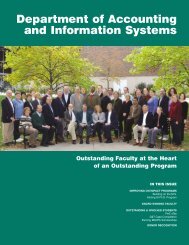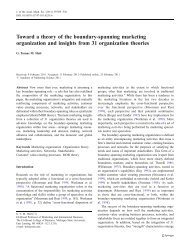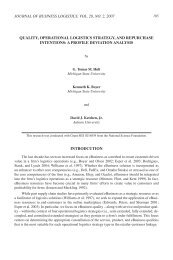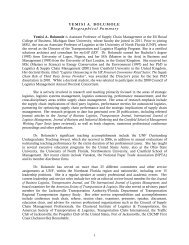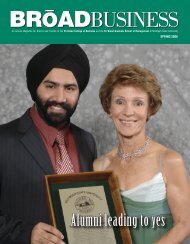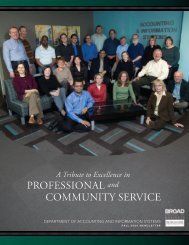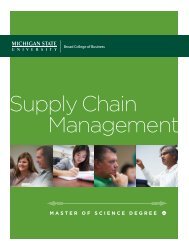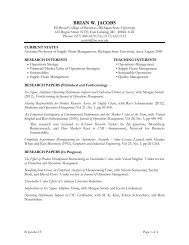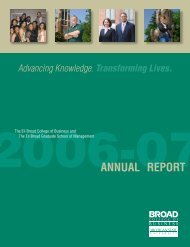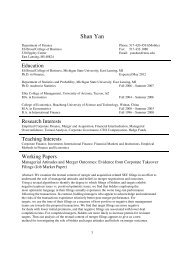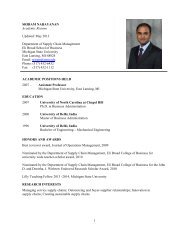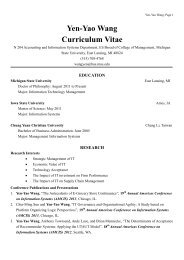Networks of action in social science research - Routines - Michigan ...
Networks of action in social science research - Routines - Michigan ...
Networks of action in social science research - Routines - Michigan ...
- No tags were found...
You also want an ePaper? Increase the reach of your titles
YUMPU automatically turns print PDFs into web optimized ePapers that Google loves.
SBE 2020 White Paper <strong>Networks</strong> <strong>of</strong> <strong>action</strong> <strong>in</strong> <strong>social</strong> <strong>science</strong> <strong>research</strong> 1,2 Brian T. Pentland Eli Broad College <strong>of</strong> Bus<strong>in</strong>ess <strong>Michigan</strong> State University E. Lans<strong>in</strong>g, MI 48824-‐1122 ABSTRACT Social and economic <strong>research</strong> has traditionally focused on familiar units <strong>of</strong> analysis, such as <strong>in</strong>dividuals, groups and firms. In this white paper, I suggest that networks <strong>of</strong> <strong>action</strong> might provide a fruitful addition to our repertoire as a basic unit <strong>of</strong> analysis <strong>in</strong> <strong>social</strong> and economic <strong>research</strong>. A network <strong>of</strong> <strong>action</strong> can be used to represent recognizable, repetitive patterns <strong>of</strong> <strong>in</strong>terdependent <strong>action</strong>s, typically carried out by multiple actors. Such patterns are the foundation <strong>of</strong> economic organization (e.g., organizational rout<strong>in</strong>es) and <strong>social</strong> <strong>in</strong>stitutions <strong>in</strong> general. Two current trends make <strong>research</strong> on <strong>action</strong> networks feasible: (a) on-‐go<strong>in</strong>g improvement <strong>in</strong> our tools for pattern recognition and network analysis; and (b) <strong>in</strong>creased availability <strong>of</strong> data that results from digitization <strong>of</strong> economic and <strong>social</strong> processes. Revers<strong>in</strong>g figure and ground, and focus<strong>in</strong>g on <strong>action</strong>s, rather than actors, provides an opportunity to address <strong>social</strong> and economic <strong>research</strong> from a new perspective. <strong>Networks</strong> <strong>of</strong> <strong>action</strong> as a unit <strong>of</strong> analysis The <strong>social</strong> world is filled with patterns <strong>of</strong> <strong>action</strong>. With<strong>in</strong> organizations, patterns <strong>of</strong> <strong>action</strong> make up the basic work processes that transform <strong>in</strong>puts <strong>in</strong>to outputs. In society <strong>in</strong> general, patterns <strong>of</strong> <strong>action</strong> produce and reproduce all k<strong>in</strong>ds <strong>of</strong> <strong>social</strong> and economic outcomes. While this seems obvious, <strong>social</strong> <strong>science</strong> <strong>research</strong> generally focuses on the actors (<strong>in</strong>dividuals, groups, organizations, etc.) and their properties (attitudes, demographics, network position, etc). Actions are treated as secondary. In this white paper, I suggest that NSF should promote <strong>research</strong> that makes patterns <strong>of</strong> <strong>action</strong> the direct focus <strong>of</strong> <strong>in</strong>quiry. This <strong>research</strong> would <strong>in</strong>volve a number <strong>of</strong> challenges, such as: • How to gather mean<strong>in</strong>gful data on <strong>action</strong> patterns? • How to scale up from analyz<strong>in</strong>g a few patterns, over a small span <strong>of</strong> time, to analyz<strong>in</strong>g ecologies <strong>of</strong> patterns as they change and evolve over time? This l<strong>in</strong>e <strong>of</strong> <strong>research</strong> is promis<strong>in</strong>g because it matches our grow<strong>in</strong>g capabilities <strong>in</strong> network analysis and pattern recognition to the grow<strong>in</strong>g availability <strong>of</strong> data on events and <strong>action</strong>s that is the natural by-‐product <strong>of</strong> <strong>in</strong>creased digitization <strong>in</strong> organizations and society <strong>in</strong> general (e.g., workflow systems, 1 This work is licensed under the Creative Commons Attribution-‐NoDerivs 3.0 Unported License. To view a copy <strong>of</strong> this license, visit http://creativecommons.org/licenses/by-‐nd/3.0/ or send a letter to Creative Commons, 171 Second Street, Suite 300, San Francisco, California, 94105, USA. 2 I want to thank Martha Feldman for her comments on a draft <strong>of</strong> this document. Many <strong>of</strong> the ideas expressed here flow from our <strong>research</strong> and writ<strong>in</strong>g on organizational rout<strong>in</strong>es.
<strong>Networks</strong> <strong>of</strong> <strong>action</strong> cloud comput<strong>in</strong>g, cell networks, etc.). The ability to track patterns as they change over time, and expla<strong>in</strong> those changes, seems particularly promis<strong>in</strong>g. This idea builds on the work <strong>of</strong> Andrew Abbott, who has been advocat<strong>in</strong>g the analysis <strong>of</strong> sequence and event data <strong>in</strong> sociological <strong>research</strong> s<strong>in</strong>ce the early 1990s. With recent progress <strong>in</strong> the available tools and sources <strong>of</strong> data, we are poised to make significant advances and apply these methods to a broad range <strong>of</strong> <strong>social</strong> phenomena. This l<strong>in</strong>e <strong>of</strong> <strong>research</strong> <strong>of</strong>fers transformative potential because, <strong>in</strong> effect, it <strong>in</strong>troduces a new unit <strong>of</strong> analysis <strong>in</strong>to <strong>social</strong> <strong>science</strong> <strong>research</strong>. Traditional units <strong>of</strong> analysis <strong>in</strong>clude <strong>in</strong>dividuals, groups, organizations and so on. This approach focuses on patterns <strong>of</strong> <strong>action</strong> as the unit <strong>of</strong> analysis. In some respects, this is a simple reversal <strong>of</strong> figure and ground; the scene is the same, but we focus on the <strong>action</strong>s rather than the actors. But the shift is transformational because it is allows us to study certa<strong>in</strong> k<strong>in</strong>ds <strong>of</strong> <strong>social</strong> and economic phenomena directly, rather than study<strong>in</strong>g their outl<strong>in</strong>es or shadows. An Example: Invoice process<strong>in</strong>g To help visualize the concept <strong>of</strong> an <strong>action</strong> network, consider the example <strong>of</strong> <strong>in</strong>voice process<strong>in</strong>g. In this <strong>research</strong>, data were collected from a computerized workflow system for process<strong>in</strong>g <strong>in</strong>voices (Pentland, Haerem and Hillison, 2010). In addition to help<strong>in</strong>g participants perform the work, the workflow system provides a digitized, archival record <strong>of</strong> the sequence <strong>of</strong> <strong>action</strong>s required to process each <strong>in</strong>voice. We collected data on two rout<strong>in</strong>es that are required to process each <strong>in</strong>voice: a data entry rout<strong>in</strong>e and an approval rout<strong>in</strong>e. Figure 1 shows these two rout<strong>in</strong>es represented as directed graphs. Each node <strong>in</strong> the graph represents a type <strong>of</strong> <strong>action</strong>, while the arcs represent the sequential relationship between <strong>action</strong>s. These graphs are like first order Markov models, except that the nodes are events rather than states. The data presented here were tested for higher order effects, and these processes are first order. Statistically, the next <strong>action</strong> depends only on the current <strong>action</strong>. Invoice EntryInvoice ApprovalFigure 1: Patterns <strong>of</strong> <strong>action</strong> as directed graphs (adapted from Pentland, Haerem and Hillison 2010) Modell<strong>in</strong>g the pattern <strong>of</strong> <strong>action</strong> as a network provides a rich variety <strong>of</strong> tools to visualize, analyze and compare the structure <strong>of</strong> the patterns. For example, Figure 1 shows that the approval rout<strong>in</strong>e (on the right) is more densely connected than the entry rout<strong>in</strong>e (on the left). This <strong>in</strong>dicates greater variety or complexity <strong>in</strong> the pattern <strong>of</strong> <strong>action</strong>. 2
<strong>Networks</strong> <strong>of</strong> <strong>action</strong> The conceptual shift is from networks <strong>of</strong> people to networks <strong>of</strong> <strong>action</strong>. Even though the images <strong>in</strong> Figure 1 were generated by traditional <strong>social</strong> network s<strong>of</strong>tware, the nodes <strong>in</strong> Figure 1 are not actors; they are <strong>action</strong>s. Also, these patterns were not stationary; they were chang<strong>in</strong>g over time. This conceptual shift is potentially important because it provides a novel way to approach sociomaterial systems – systems that <strong>in</strong>volve heterogeneous networks <strong>of</strong> human and non-‐human actants (e.g., <strong>in</strong>formation and communication technologies). Approximately 65 people were <strong>in</strong>volved <strong>in</strong> carry<strong>in</strong>g out the patterns <strong>of</strong> <strong>action</strong> shown <strong>in</strong> Figure 1, but only about half <strong>of</strong> the <strong>action</strong>s were performed by those people. The rest <strong>of</strong> the <strong>action</strong>s were performed by the workflow system itself, which can take <strong>action</strong>s based on rules that have been programmed <strong>in</strong>to it. For example, when all approvals are complete, each <strong>in</strong>voice is automatically queued for transfer to the accounts payable system. Thus, the patterns <strong>of</strong> <strong>action</strong> shown <strong>in</strong> Figure 1 were generated by a comb<strong>in</strong>ation <strong>of</strong> human and non-‐human actants. Capability to be created/Scientific strategy Many <strong>of</strong> the core capabilities required for this l<strong>in</strong>e <strong>of</strong> <strong>research</strong> already exist. These <strong>in</strong>clude tools for network analysis developed by sociologists (such as UCINET and SIENNA), and tools for pattern recognition developed by computer scientists. With NSF support, (NSF-‐0924786, Innovation and Organization Science), we are work<strong>in</strong>g on apply<strong>in</strong>g and extend<strong>in</strong>g these tools to explore path dependence <strong>in</strong> repetitive patterns <strong>of</strong> <strong>action</strong> <strong>in</strong> the context <strong>of</strong> organizational rout<strong>in</strong>es. To use <strong>action</strong> patterns as the unit <strong>of</strong> analysis <strong>in</strong> a broader range <strong>of</strong> phenomena, some additional def<strong>in</strong>itional, theoretical and methodological work is needed. Some basic issues <strong>in</strong>clude: Identification. How can we def<strong>in</strong>e the boundaries on a pattern <strong>of</strong> <strong>action</strong>, to create an identifiable unit <strong>of</strong> analysis? In other words, when can we say that two patterns <strong>of</strong> <strong>action</strong> are <strong>of</strong> the same k<strong>in</strong>d or category? Comparison. How can patterns <strong>of</strong> <strong>action</strong> be compared (cross-‐sectionally and over time)? A fairly extensive set <strong>of</strong> tools already exists for this, but further def<strong>in</strong>ition and codification would be useful. Hierarchical nest<strong>in</strong>g. Actions can usually be reduced <strong>in</strong>to f<strong>in</strong>er-‐gra<strong>in</strong>ed sub-‐<strong>action</strong>s, result<strong>in</strong>g <strong>in</strong> a potential <strong>in</strong>f<strong>in</strong>ite regress <strong>in</strong> granularity. Thus, reasonable pr<strong>in</strong>ciples need to be established for def<strong>in</strong><strong>in</strong>g relationships between patterns. Time and space. Patterns <strong>of</strong> <strong>action</strong> can be widely distributed <strong>in</strong> time and space, and they may operate at different time scales, which complicates the problems <strong>of</strong> identification and comparison mentioned above. Visualization. Many excellent visualizations exist; the network graphs shown <strong>in</strong> Figure 1 are among the simplest. With this k<strong>in</strong>d <strong>of</strong> complex phenomenon, visualization can be very useful. S<strong>in</strong>ce methods are relatively well developed, the key issue is availability <strong>of</strong> mean<strong>in</strong>gful data on <strong>action</strong>s and events. Traditionally, this k<strong>in</strong>d <strong>of</strong> data has been collected through qualitative fieldwork. Researchers like Stephen Barley and Martha Feldman have conducted <strong>in</strong>fluential studies us<strong>in</strong>g traditional field <strong>research</strong> methods. I expect that qualitative field <strong>research</strong> would be necessary to cont<strong>in</strong>ued progress <strong>in</strong> this doma<strong>in</strong>. 3
<strong>Networks</strong> <strong>of</strong> <strong>action</strong> The new opportunity, however, comes from the <strong>in</strong>creased potential <strong>of</strong> archival data that is generated as a by-‐product <strong>of</strong> network-‐based digital communications and workflows. As with the use <strong>of</strong> any archival electronic data source, privacy is likely to be a concern. I would th<strong>in</strong>k that the ideal <strong>research</strong> project would conta<strong>in</strong> both qualitative fieldwork (to ensure validity and provide conceptual clarity), and the analysis <strong>of</strong> archival sources (to foster generality and to detect patterns that <strong>in</strong>dividual fieldworkers would not be able to see). Intellectual Context S<strong>in</strong>ce the 1950s, Herbert Simon, James March, Sidney W<strong>in</strong>ter, Michael Cohen and others have placed rout<strong>in</strong>es (repetitive patterns <strong>of</strong> <strong>action</strong>) at the center <strong>of</strong> economic organization. Over the last several years, Martha Feldman and I have emphasized the practice-‐based view <strong>of</strong> rout<strong>in</strong>es, which emphasizes that rout<strong>in</strong>es can be understood as repetitive patterns <strong>of</strong> <strong>in</strong>terdependent <strong>action</strong> carried out by multiple actors. I selected Pentland and Feldman (2007) as recommended as background read<strong>in</strong>g because it expla<strong>in</strong>s the network perspective, and makes connections to the role <strong>of</strong> <strong>in</strong>formation and communication technologies. Recent advances <strong>in</strong> methodology and the availability <strong>of</strong> data have made it possible to analyze patterns <strong>of</strong> <strong>action</strong> based on large samples <strong>of</strong> data. This work provides a “pro<strong>of</strong>-‐<strong>of</strong>-‐concept” for a broader l<strong>in</strong>e <strong>of</strong> <strong>research</strong> on patterns <strong>of</strong> <strong>action</strong> (e.g., Pentland, Haerem and Hillison 2010). Scholars <strong>in</strong>terested <strong>in</strong> large scale <strong>social</strong> network analysis provide another important po<strong>in</strong>t <strong>of</strong> reference. Studies based on Internet traffic and cell phone records have broken new ground <strong>in</strong> the analysis <strong>of</strong> <strong>social</strong> structures. However, it is important to note that their work is still focused on traditional networks <strong>of</strong> actors, not networks <strong>of</strong> <strong>action</strong>. In some respects, <strong>action</strong> patterns can be seen as related to “memes”, an idea <strong>in</strong>troduced by Richard Dawk<strong>in</strong>s. However, the “meme” is primarily a cognitive concept, connected to <strong>in</strong>dividual level psychology; memes spread “from m<strong>in</strong>d to m<strong>in</strong>d.” The focus here is behavioral. Further, patterns <strong>of</strong> <strong>action</strong> are <strong>of</strong>ten distributed across multiple actors, and those actors may or may not be human. Stand<strong>in</strong>g questions Andrew Abbott has shown that many traditional <strong>social</strong> <strong>science</strong> questions about objects (e.g., people or organizations) can be restated and analyzed <strong>in</strong> terms <strong>of</strong> <strong>action</strong>s. Here are some examples <strong>of</strong> questions that might be addressed <strong>in</strong> this <strong>research</strong> program. They are phrased here <strong>in</strong> terms <strong>of</strong> “organizational rout<strong>in</strong>es,” s<strong>in</strong>ce that has been my own discipl<strong>in</strong>ary <strong>in</strong>terest, but similar phenomena could be <strong>in</strong>vestigated <strong>in</strong> any context where patterns <strong>of</strong> <strong>action</strong> occur. 1) Stability and change. • How do patterns <strong>of</strong> <strong>action</strong> react to environmental change? In organization theory, rout<strong>in</strong>es are famous for be<strong>in</strong>g resistant to change (a source <strong>of</strong> <strong>in</strong>ertia). At the same time, rout<strong>in</strong>es can also drift and change over time. • Can change with<strong>in</strong> a low level rout<strong>in</strong>e propagate to higher level rout<strong>in</strong>es? To the extent that rout<strong>in</strong>es exist <strong>in</strong> nested hierarchies, it seems important to explore how hierarchical structures enable or constra<strong>in</strong> change over time. 2) Diffusion <strong>of</strong> <strong>in</strong>novation (and other phenomena <strong>in</strong>volv<strong>in</strong>g propagation). • How does change propagate among rout<strong>in</strong>es? In <strong>social</strong> networks, complex contagion is generally stronger than simple contagion (peer pressure is stronger when it comes from 4
<strong>Networks</strong> <strong>of</strong> <strong>action</strong> multiple peers). But do the same k<strong>in</strong>ds <strong>of</strong> effects occur <strong>in</strong> networks <strong>of</strong> rout<strong>in</strong>es? Remember that <strong>in</strong> a rout<strong>in</strong>e, different <strong>action</strong>s may be carried out by different actors; there is not necessarily a one-‐to-‐one mapp<strong>in</strong>g. 3) How can we account for the role <strong>of</strong> artifacts? • How does the mix <strong>of</strong> human and non-‐human actors affect patterns <strong>of</strong> <strong>action</strong>? In real rout<strong>in</strong>es, many actors are not human (consider workflow systems, for example). The properties <strong>of</strong> non-‐human actors may <strong>in</strong>fluence variation, selection and retention <strong>of</strong> the overall system. The role <strong>of</strong> artifacts is important because <strong>social</strong> and economic phenomena are mediated by technology. Recent work by Stephen Barley, Wanda Orlikowski, and others has emphasized the role <strong>of</strong> sociomateriality. Orlikowski (2007) is recommended background read<strong>in</strong>g because it makes a forceful and eloquent case for the <strong>in</strong>clusion <strong>of</strong> material artifacts <strong>in</strong> <strong>social</strong> <strong>science</strong> <strong>research</strong>. For years, <strong>social</strong> scientists have struggled with ways to <strong>in</strong>corporate technology (especially <strong>in</strong>formation and communication technology), with limited success. The approach advocated here provides a common denom<strong>in</strong>ator – patterns <strong>of</strong> <strong>action</strong> – that can be used to <strong>in</strong>vestigate sociomaterial systems regardless <strong>of</strong> the mix <strong>of</strong> actants. Range <strong>of</strong> discipl<strong>in</strong>es that could contribute There are several discipl<strong>in</strong>es that could fruitfully contribute to this l<strong>in</strong>e <strong>of</strong> <strong>research</strong>, <strong>in</strong>clud<strong>in</strong>g: • Computer <strong>science</strong> (pattern recognition and process m<strong>in</strong><strong>in</strong>g); • Sociology (network analysis and qualitative field studies); • Organization theory (repetitive patterns <strong>of</strong> <strong>action</strong> are def<strong>in</strong>itional <strong>of</strong> the phenomena we recognize as “organization”). Application areas <strong>in</strong>clude healthcare, public health, energy and environment, technological <strong>in</strong>novation, and so on. Implications for future <strong>research</strong> with<strong>in</strong> and across discipl<strong>in</strong>es It is difficult to say what the implications this <strong>research</strong> might have. However, the transformative potential is considerable because we are talk<strong>in</strong>g about a new unit <strong>of</strong> analysis <strong>in</strong> <strong>social</strong> <strong>science</strong> <strong>research</strong>. Analysis <strong>of</strong> <strong>action</strong> patterns would provide a new approach to some truly foundational questions <strong>in</strong> <strong>social</strong> theory, as well as potential <strong>in</strong>sights <strong>in</strong>to practical problems that h<strong>in</strong>ge on our ability to detect and <strong>in</strong>fluence patterns <strong>of</strong> <strong>action</strong> <strong>in</strong> society. Three background read<strong>in</strong>gs Orlikowski, W. J. (2007). “Sociomaterial practices: Explor<strong>in</strong>g technology at work,” Organization Studies, 28, 1435-‐48. Pentland, B. T. and Feldman, M. S. (2007) “Narrative <strong>Networks</strong>: Patterns <strong>of</strong> technology and organization,” Organization Science, 18(5), 781-‐795. Pentland , B, T. Haerem and D. Hillison (2010) “Compar<strong>in</strong>g Organizational Rout<strong>in</strong>es as Recurrent Patterns <strong>of</strong> Action”, Organization Studies, 31(7), 917-940. 5



